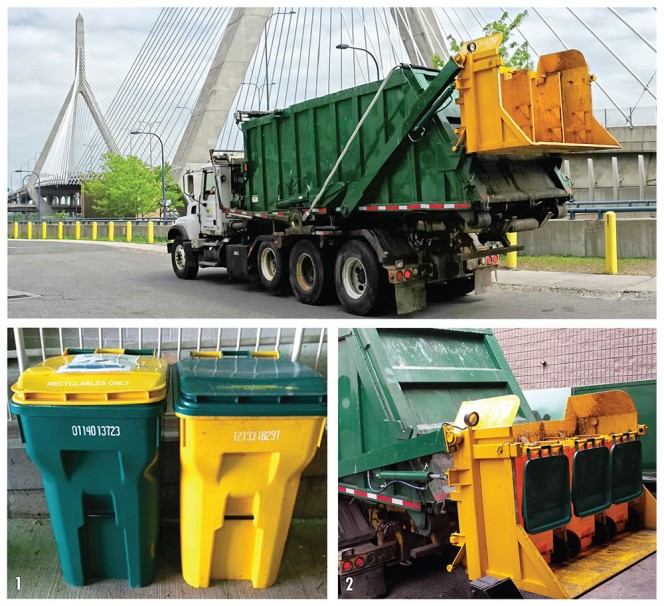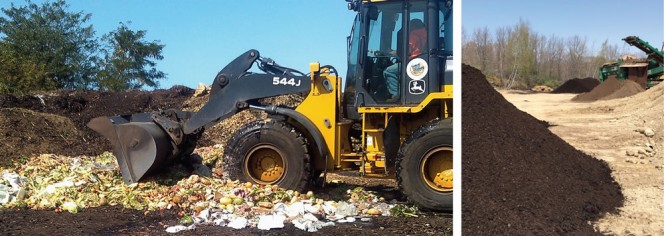Marsha W. Johnston
BioCycle January 2016, Vol. 57, No. 1 p.52

Pre and postconsumer food scraps, compostable bags and PLA cups, and milk cartons are accepted in the organics stream. Waste Management (WM) supplied 96-gallon totes with a yellow body and green lid for all organics (1, on right). Totes for single-stream recyclables have a green body and yellow lid (1, on left). WM hauls organics (totes ready to be tipped into truck (2)) to the Town of Needham (MA) composting site.
It has been 15 months since the Massachusetts Department of Environmental Protection’s solid waste disposal ban that applies to businesses and institutions disposing one ton or more of food waste per week became effective. Large businesses and institutions around the state have taken steps to comply, including Patriot Place in Foxborough, the 1.3 million-square-foot shopping, dining and entertainment destination located adjacent to Gillette Stadium, New England’s sports and entertainment venue that houses the New England Patriots.
Patriot Place offers a mix of large and boutique retailers, entertainment venues, 16 casual to high-end dining establishments, a medical facility and special events, generating more organic waste than a traditional shopping center. Prior to launching the Waste, Recycling & Organics (WRO) initiative in October 2014, Patriot Place recycled only cardboard. From January through September 2015, the WRO initiative nearly doubled Patriot Place’s Landfill Waste Diversion Rate (LWDR) to 42 percent, compared to 23 percent in 2014, according to Michelle Lee Guiney, Sustainability Consultant and Total Recycling Program (TRP) Manager for Waste Management of New England, A total of 454 tons of material (258 tons single-stream recycling and 196 tons of organics) were diverted.
“There are so many opportunities in Massachusetts since the ban went into effect, and this shopping center is one of just a handful of venues in the state that has rolled this out and achieved impressive outcomes,” notes Guiney. The success of Patriot Place’s WRO program was all the more remarkable, she says, because such a large program requires extensive training, is time-consuming and stressful to implement at restaurants that operate 24/7, especially during the holiday season with frequent home football games and holiday shopping.
For 12 months prior to the rollout, a WRO team comprising Waste Management (WM), Patriot Place executive management and tenants, organics hauler New England Solid Waste (NESW), Agresource and the Town of Needham Solid Waste & Recycling, worked to design the program. For example, explains Guiney, NESW, primarily a commercial food waste collector subcontracted to Waste Management, “was great with assessments, estimation of the material and flow, and did a walk-around with us prior to contracting…to haul food waste away.”
Pre and postconsumer food waste is diverted, although with postconsumer, staff scrapes customer food waste into organics totes (i.e., there are no front-of-house collection containers). Compostable bags and PLA cups, and milk cartons, are also accepted. Tenant kitchens are equipped with 1.5- and 2.4-gallon countertop containers to assist with food waste capture.
Launching The WRO
With this preparation completed, WRO was launched, with every Patriot Place restaurant tenant diverting food waste, and all of its tenants starting single-stream recycling (SSR) rather than cardboard only. In the first month, WM replaced all of the center’s OCC compactors with SSR compactors, and began processing all of the recyclable waste. In addition, WM’s Total Recycle Program included support at tenant meetings, tenant setup and rollout assistance, equipment tutorials, evening and weekend container monitoring, janitorial trainings for all shifts, recommendations for optimizing container and collection service, live load audits, and regular feedback via email communication).
To help ensure proper separation of materials and troubleshoot any hiccups, Guiney was on site five to six days a week during the first quarter of the program. “I was going through every single tote and compactor, photographing and sending photos to managers and general managers so they could follow through with the tenants, and giving updates and recommendations,” she recalls. “On any of the issues, the majority of the managers were right on top of all recommendations, suggestions and corrections. The collaborative partnership at this particular venue has been phenomenal, aiding in the WRO program’s strategic development and major achievements to date.”
Areas of Patriot Place that could not fit SSR compactors continued using 96-gallon totes, a yellow body/green lidded one for all organics, and a green body/yellow-lidded one for recyclables. “Those areas had the highest rates of contamination,” Guiney notes, adding that it was due to a combination of inconvenience and confusion between the two bins, i.e., recyclables put in the organics containers and vice versa. “But in the first quarter we went from having the common contaminants in organics totes, e.g., plastic cups, film, food storage bags, recyclables, glass and aluminum, to contaminant-free.”
Indeed, in the first quarter of the project (Q4 2014), the partnership yielded significant results quickly: Landfilled waste was reduced by 32 tons despite a 17 ton increase in total solid waste materials generated by comparison than in Q4 2013; the Landfill Waste Diversion Rate went from 26 percent in Q4 2013 to 44 percent in Q4 2014; 768,000 kilowatt-hours of electricity were conserved; and 90 tons of organics were diverted from landfill, reducing greenhouse gases by 82 metric tons of CO2.
Achieving that success required Guiney’s on-site involvement. “On [Patriot] game days, 60,000-plus people were running through the retail area, and so I would check the bins on those days, but also go and observe how the staff dealt with materials management/separation in both the front and back of the house to optimize service and provide continuous improvement,” she says.

The Needham yard trimmings composting facility, located at the town’s transfer station, began taking source separated commercial organics in 2009. Yard trimmings are mixed in a 3-4:1 ratio with food scraps using a front-end loader (above) and put into windrows. Compost (left) is typically ready for curing and screening in about 3.5 months. Photos courtesy of Geoff Kuter, Agresource
Composting Loop
Today, WM services 15 compactors for trash and recycling and 60 organics totes at Patriot Place. NESW hauls the center’s food scraps about 20 miles to the 5.3-acre Town of Needham transfer station where the municipality operates a leaf and yard trimmings composting facility. Source separated organics have been included in the composting program since 2009. The Needham composting facility can process approximately 10,000 cubic yards/year of leaves and yard trimmings. It also has an allowance from the state Department of Environmental Protection to take 15 tons/day of source separated food scraps.
According to Geoff Kuter, CEO of Agresource, which markets and distributes the Needham facility’s compost to various landscaping companies, the facility “started slowly,” taking in approximately 450 tons/year of food waste from grocery stores. “But the site has now ramped up to a level that the town feels the facility can operate comfortably with the existing staff and equipment,” he adds.
In the first nine months of 2014 (January through September), Needham received 446 tons of source separated organics. During the same period in 2015, Needham received 795 tons, including the organics from Patriot Place. “The increase in food waste was substantial but was absorbed by the Town into the existing leaf and yard trimmings program,” notes Kuter. “Operators use a mix of 3 or 4:1 yard trimmings to food waste. A front end loader is used to mix the feedstocks, as well as to turn the windrows.” Adds Greg Smith, Superintendent of Solid Waste Operations for Needham: “The minor amounts of additional food waste in 2015 do not pose any problems for our capacity, as we are not yet near our permit limits on tonnages per day or per annum.”
Food waste is mixed with leaves within hours of reception to keep odors and gulls away, and turned in windrows for typically 3.5 months until the compost is ready for curing and screening. Smith says his facility has two McCloskey trommels — one purchased 10 years ago and the newer model purchased in early 2015.
Marsha Johnston, principal of Earth Steward Associates, is a Contributing Editor to BioCycle.














